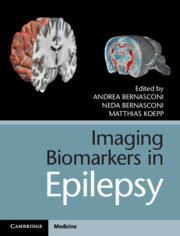Book contents
- Imaging Biomarkers in Epilepsy
- Imaging Biomarkers in Epilepsy
- Copyright page
- Dedication
- Contents
- Preface
- Contributors
- Part I Imaging the Development and Early Phase of the Disease
- Part II Modeling Epileptogenic Lesions and Mapping Networks
- Chapter 6 Computational Neuroimaging of Epilepsy
- Chapter 7 Imaging White Matter Pathology in Epilepsy
- Chapter 8 Network Modeling of Epilepsy Using Structural and Functional MRI
- Chapter 9 Mapping Metabolism and Inflammation in Epilepsy
- Chapter 10 Interictal and Ictal Brain Network Changes in Focal Epilepsy
- Chapter 11 Ictal Events Imaged through SPECT
- Chapter 12 Imaging Cortical and Subcortical Circuitry in Generalized Epilepsies
- Part III Predicting the Response to Therapeutic Interventions
- Part IV Mapping Consequences of the Disease
- Index
- References
Chapter 9 - Mapping Metabolism and Inflammation in Epilepsy
from Part II - Modeling Epileptogenic Lesions and Mapping Networks
Published online by Cambridge University Press: 07 January 2019
- Imaging Biomarkers in Epilepsy
- Imaging Biomarkers in Epilepsy
- Copyright page
- Dedication
- Contents
- Preface
- Contributors
- Part I Imaging the Development and Early Phase of the Disease
- Part II Modeling Epileptogenic Lesions and Mapping Networks
- Chapter 6 Computational Neuroimaging of Epilepsy
- Chapter 7 Imaging White Matter Pathology in Epilepsy
- Chapter 8 Network Modeling of Epilepsy Using Structural and Functional MRI
- Chapter 9 Mapping Metabolism and Inflammation in Epilepsy
- Chapter 10 Interictal and Ictal Brain Network Changes in Focal Epilepsy
- Chapter 11 Ictal Events Imaged through SPECT
- Chapter 12 Imaging Cortical and Subcortical Circuitry in Generalized Epilepsies
- Part III Predicting the Response to Therapeutic Interventions
- Part IV Mapping Consequences of the Disease
- Index
- References
- Type
- Chapter
- Information
- Imaging Biomarkers in Epilepsy , pp. 95 - 107Publisher: Cambridge University PressPrint publication year: 2019

